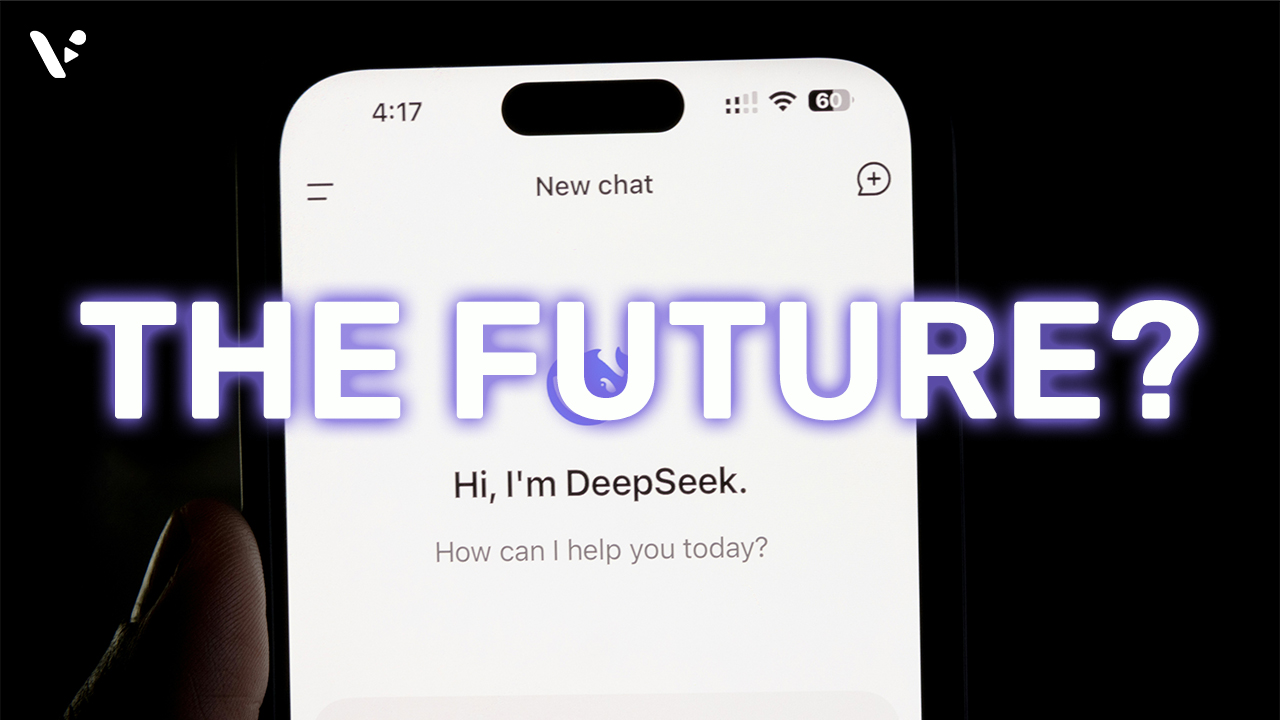If you’re into AI, you’ve probably heard whispers—or outright debates—about DeepSeek . It’s the latest large language model (LLM) making waves, and its impact has been nothing short of seismic. Whether it’s outperforming expectations on a tight budget, being accused (but not proven) of copying ChatGPT, or raising some serious privacy red flags, DeepSeek has everyone in the AI world talking.
What is DeepSeek?

Chinese AI startup DeepSeek recently released two new AI models: V3 and R1. Both are powerful, but they serve different purposes. Here’s what you need to know.
DeepSeek V3: the generalist
V3 is a well-rounded, general-purpose model built to handle a wide range of tasks. It was trained on a massive dataset of 14.8 trillion tokens, mostly in English and Chinese, with a strong focus on coding and math. One of its biggest strengths is its long context window, which stretches up to 128,000 tokens. That means it can process and remember way more information at once, making it great for tasks that need deep context, like summarizing long reports or analyzing complex documents.
V3 also predicts multiple tokens at a time, which speeds up responses. This means that it performs at the level of top models like GPT-4o and Claude 3.5 Sonnet, but at a fraction of the cost. DeepSeek reportedly trained this model on 2,048 Nvidia H800 GPUs over just 55 days, spending around $5.6 million, which is incredibly low compared to what OpenAI and Google are spending. However, some have disputed this number.
DeepSeek R1: the deep thinker
R1 is different. It’s built specifically for reasoning tasks—the kind where step-by-step logic matters. While it shares some of V3’s foundations, it was fine-tuned to explain its thinking as it solves problems. This makes it ideal for things like complex problem-solving, decision-making, and breaking down arguments.
DeepSeek also experimented with different training approaches for R1. Some versions were trained entirely with reinforcement learning, skipping the usual supervised fine-tuning process. Despite the unconventional method, R1 competes with top-tier models, such as OpenAI’s o1, in reasoning-heavy tasks.
Why DeepSeek matters
DeepSeek is a classic case of second-mover advantage. OpenAI, Google, and Anthropic spent billions pushing the frontiers of AI. But DeepSeek sat back, learned from their successes and mistakes, and built something leaner, cheaper, and just as good.
This is bad news for big AI companies. They’ve relied on their massive research budgets as a competitive moat, keeping smaller players from catching up. But DeepSeek proves you don’t need a multi-billion-dollar budget to make a top-tier AI model. If they can do it, who else will?
Did DeepSeek copy ChatGPT? The (currently unproven) allegations
With any disruptive tech, there are always accusations. Some industry experts suspect that DeepSeek might have used OpenAI’s ChatGPT to train its model. The theory? Model distillation, allegedly.
Model distillation is when a smaller AI model learns by mimicking the outputs of a larger one. Instead of training from scratch, the student model “learns” patterns and behaviors from a teacher model. This is a very common technique in the industry and is an effective way to create smaller, more efficient models. If DeepSeek did this using OpenAI’s ChatGPT, it could explain why it is so effective despite its reportedly lower training budget.
But here’s the thing: No one has actually proven this. OpenAI is reportedly investigating, but as of now, it’s just speculation.
Whether or not distillation played a role, DeepSeek’s success suggests that OpenAI’s moat might not be as wide as they thought. Even if DeepSeek played fair, other companies will find ways to train AI cheaper and faster. That changes everything.
DeepSeek, ChatGPT, and data privacy
Privacy concerns are a huge deal in AI, and DeepSeek is already under scrutiny. South Korea’s National Intelligence Service (NIS) claims that DeepSeek “excessively” collects personal data. They allege that:
- DeepSeek transfers chat logs and keystroke data to servers in China.
- User data might be shared with advertisers and third parties without proper consent.
- The model’s data practices lack transparency, making it a potential national security risk.
As a result, South Korea has blocked DeepSeek on government devices, and other countries are considering similar actions. If these allegations hold up, DeepSeek could face serious legal and reputational damage.
For comparison, ChatGPT has had its own privacy struggles. OpenAI was fined in Italy for violating GDPR rules, and ChatGPT has faced security breaches that exposed users’ chat histories. But unlike DeepSeek, OpenAI operates in the U.S. and Europe, where there are strict regulations on how data is collected and used.
The takeaway? DeepSeek ’s privacy concerns seem more severe than ChatGPT’s—at least for now.
What this means for the future of AI
DeepSeek is shaking things up. Here’s what might happen next:
- Big Tech Will Need to Adapt
- OpenAI, Google, and Anthropic can’t rely on unlimited funding as a barrier anymore. If a startup can build a competitive LLM for under $10 million, the game has changed. Expect them to double down on efficiency and speed.
- More Countries Will Investigate AI Privacy
- Governments worldwide are already nervous about AI and data security. DeepSeek ’s privacy issues could push more countries to enforce stricter AI regulations. We might see new laws restricting where and how AI models collect data.
- The Rise of Lean AI Models
- Not every company can afford to train an AI model like GPT-4. But now, startups know that you can build a great model for a fraction of the cost. Expect more “budget” AI models coming from new players worldwide.
- DeepSeek Might Face Legal Trouble
- If OpenAI finds proof of model distillation, lawsuits are coming. And if South Korea’s accusations hold up, other governments might take action against DeepSeek, limiting its reach.
- More AIs Could Be Developed for Cheap
- If DeepSeek really managed to develop at the cost they claim, it could inspire a wave of startups and research labs to try similar approaches. This might lead to a boom in AI development at lower costs, further disrupting the dominance of major AI companies.
Follow Visla to make sure you’re up-to-date on all the latest developments in AI.

